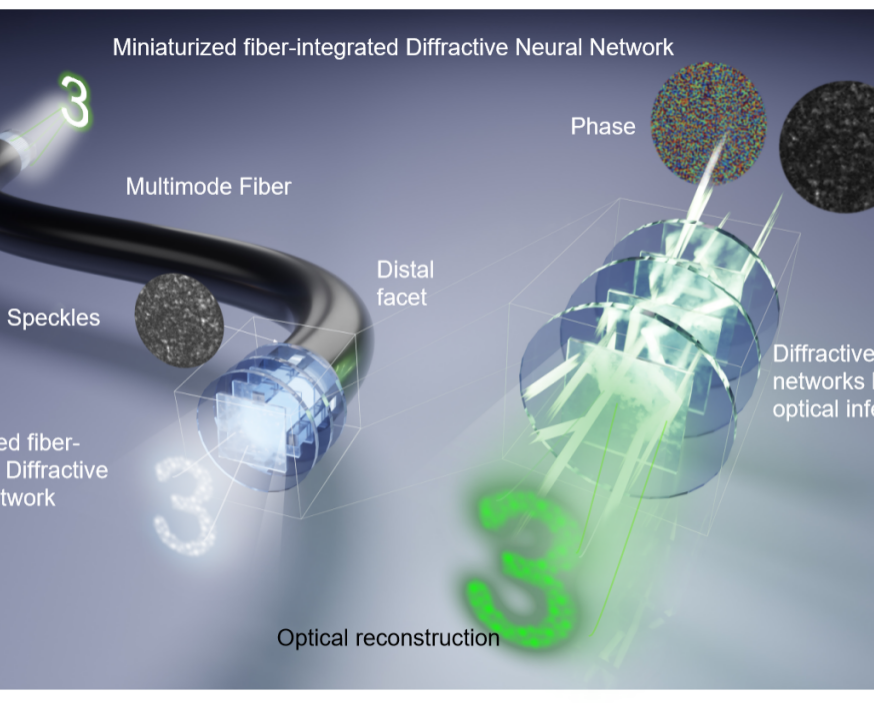Reviewed by Lexie CornerFeb 11 2025
A research team led by Prof. Qiming Zhang and Associate Prof. Haoyi Yu from the University of Shanghai for Science and Technology (USST) integrated miniaturized multilayer optical diffractive neural networks (DN2s) onto the distal end of multimode fibers (MMFs), enabling full-optical image transmission.
 Miniatured fiber-integrated Diffractive Neural Network. Image Credit: University of Shanghai for Science and Technology
Miniatured fiber-integrated Diffractive Neural Network. Image Credit: University of Shanghai for Science and Technology
Optical fibers are widely used in modern science and technology due to their efficiency and security in applications such as internet connectivity and large-scale data transmission.
Compared to single-mode fibers (SMFs), MMFs support a significantly higher number of guided modes (~10³ to ~10⁴), allowing high-capacity information and image transfer within a fiber the width of a human hair. This capability makes MMFs valuable for applications in quantum information processing and micro-endoscopy.
However, MMFs present a significant challenge: their highly scattering nature leads to severe modal dispersion, which degrades transmitted information quality. Existing techniques, including artificial neural networks (ANNs) and spatial light modulators (SLMs), have achieved limited success in reconstructing distorted images during MMF transmission.
Despite these efforts, the direct optical transmission of undistorted images through MMFs using micron-scale integrated optical components remains an unresolved challenge in optical research.
Innovation
The team at USST achieved full-optical image transmission by integrating miniaturized multilayer optical DN2s onto the distal end of MMFs. Free-space diffractive neural networks, classified as optical neural networks (ONNs), have been proposed as efficient alternatives to ANNs for optical matrix multiplication, using deep learning to process data at the speed of light. ANNs feature a high number of connections, making them applicable to optical image classification, decryption, and phase detection.
In this study, the researchers fabricated a DN2s structure with a footprint of 150 μm × 150 μm at the distal facet of a commercial 0.35-meter-long MMF using a 3D galvo-scanning two-photon nanolithographic (GS-TPN) technique.
Operating in the visible wavelength range, the fiber-integrated DN2s, based on multilayer diffractive elements, reconstructs images by optically inferring the amplitude and phase information of speckle patterns.
The system achieved an average optical intensity contrast of approximately 4 % and a diffraction efficiency of around 35 % per layer. It demonstrated high imaging performance by reconstructing handwritten digits with a minimum feature size of 4.90 μm for real-time input images of 65 μm × 65 μm. Additionally, the system exhibited transfer learning capabilities.
The platform maintained high-quality optical image reconstruction when transmitting 31 HeLa cell images that were not part of the training dataset, demonstrating the potential for combining miniaturized DN2s with MMFs as a micron-scale optical inference platform. This approach could enable compact photonic systems with diverse applications.
Summary and Outlook
This study successfully integrated multilayer optical DN2s with MMFs to achieve direct optical image transmission. The system has potential applications in compact photonic systems, where it could use the computational capabilities of diffractive neural networks for extended functionality.
Integrating miniaturized DN2s at the fiber facet provides a micrometer-scale platform for MMF-based technologies in mode sorting, MMF signal transmission, rigid endoscopes, and short-range quantum optical interconnects. This approach could also be adapted to single-mode, gradient-index, and disordered fiber systems.